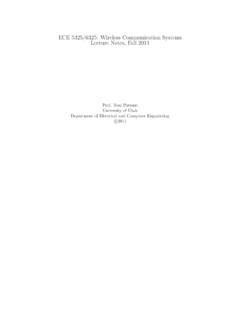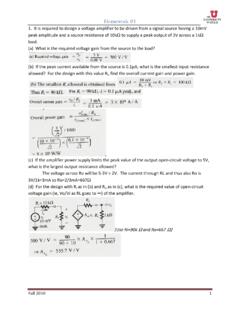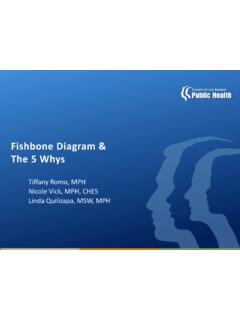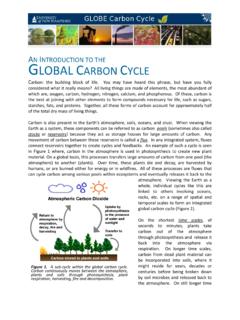Transcription of Introduction to Bode Plot - University of Utah
1 Introduction to Bode plot 2 plots both have logarithm of frequency on x-axis o y-axis magnitude of transfer function, H(s), in dB o y-axis phase angle The plot can be used to interpret how the input affects the output in both magnitude and phase over frequency. Where do the Bode diagram lines comes from? 1) Determine the Transfer Function of the system: )()()(11psszsKsH++= 2) Rewrite it by factoring both the numerator and denominator into the standard form )1()1()(1111++=psspzsKzsH where the z s are called zeros and the p s are called poles. 3) Replace s with j?. Then find the Magnitude of the Transfer Function. )1()1()(1111++=pjwjwpzjwKzjwH If we take the log10 of this magnitude and multiply it by 20 it takes on the form of 20 log10 (H(jw)) = ++)1()1(log20111110pjwjwpzjwKz= )1(log20log20log20)1(log20log20log201101 011011011010+ +++zjwjwpzjwzK Each of these individual terms is very easy to show on a logarithmic plot .
2 The entire Bode log magnitude plot is the result of the superposition of all the straight line terms. This means with a little practice, we can quickly sketch the effect of each term and quickly find the overall effect . To do this we have to understand the effect of the different types of terms. These include: 1) Constant terms K 2) Poles and Zeros at the origin | j? | 3) Poles and Zeros not at the origin 11pj +or 11zj + 4) Complex Poles and Zeros (addressed later) effect of Constant Terms: Constant terms such as K contribute a straight horizontal line of magnitude 20 log10(K) H = K effect of Individual Zeros and Poles at the origin: A zero at the origin occurs when there is an s or j?
3 Multiplying the numerator. Each occurrence of this causes a positively sloped line passing through ? = 1 with a rise of 20 db over a decade. H = | j| A pole at the origin occurs when there are s or j? multiplying the denominator. Each occurrence of this causes a negatively sloped line passing through ? = 1 with a drop of 20 db over a decade. H = j1 effect of Individual Zeros and Poles Not at the Origin Zeros and Poles not at the origin are indicated by the (1+j?/zi) and (1+j?/pi). The values zi and pi in each of these expression is called a critical frequency (or break frequency).
4 Below their critical frequency these terms do not contribute to the log magnitude of the overall plot . Above the critical frequency, they represent a ramp function of 20 db per decade. Zeros give a positive slope. Poles produce a negative slope. H = iipjzj ++11 20 log10(K) ? 1 10 100 (log scale) 20 log10(H) ? 1 10 100 (log10 scale) 20 log(H) -20 db dec. dec. +20 db zi pi -20 db ? 1 10 100 (log scale) 20 log(H) dec ? 1 10 100 (log scale) 20 log(H) 20 db dec To complete the log magnitude vs. frequency plot of a Bode diagram, we superposition all the lines of the different terms on the same plot . Example 1: For the transfer function given, sketch the Bode log magnitude diagram which shows how the log magnitude of the system is affected by changing input frequency.
5 (TF=transfer function) 12100 TFs=+ Step 1: Repose the equation in Bode plot form: 1100150 TFs =+ recognized as 111 KTFsp=+ with K = and p1 = 50 For the constant, K: 20 log10( ) = -40 For the pole, with critical frequency, p1: Example 2: Your turn. Find the Bode log magnitude plot for the transfer function, 425105052500xsTFss=++ Start by simplifying the transfer function form: 50 -40 db 0db ? (log scale) 20 log10(MF) Example 2 Solution: Your turn. Find the Bode log magnitude plot for the transfer function, 425105052500xsTFss=++ Simplify transfer function form: 44510510205*500(5)(500)(1)(1)(1)(1)55005 500xsxssTFssssss===++++++ Recognize: K = 20 20 log10(20) = 1 zero at the origin 2 poles: at p1 = 5 and p2=500 Technique to get started: 1) Draw the line of each individual term on the graph 2) Follow the combined pole-zero at the origin line back to the left side of the graph.
6 3) Add the constant offset, 20 log10(K), to the value where the pole/zero at the origin line intersects the left side of the graph. 4) Apply the effect of the poles/zeros not at the origin. working from left (low values) to right (higher values) of the poles/zeros. 0 db -40 db 100 80 db -80 db 40 db 103 102 101 ? (log scale) Example 3: One more time. This one is harder. Find the Bode log magnitude plot for the transfer function, 200(20)(21)(40)sTFsss+=++ Simplify transfer function form: 0 db -40 db 100 80 db -80 db 40 db 103 102 101 20log10(TF) ? (log scale) 0 db -40 db 100 80 db -80 db 40 db 103 102 101 ? (log scale) Technique to get started: 1) Draw the line of each individual term on the graph 2) Follow the combined pole-zero at the origin line back to the left side of the graph.
7 3) Add the constant offset, 20 log10(K), to the value where the pole/zero at the origin line intersects the left side of the graph. 4) Apply the effect of the poles/zeros not at the origin. working from left (low values) to right (higher values) of the poles/zeros. Example 3 Solution: Find the Bode log magnitude plot for the transfer function, 200(20)(21)(40)sTFsss+=++ Simplify transfer function form: 200*20(1)100(1)200(20)402020(21)(40)(1)( 1)(1)(1) +++===++++++ Recognize: K = 100 20 log10(100) = 40 1 pole at the origin 1 zero at z1 = 20 2 poles: at p1 = and p2=40 0 db -40 db 100 80 db -80 db 40 db 103 102 101 20log10(TF) 40 db/dec 20 db/dec 20 db/dec 40 db/dec ?
8 (log scale) Technique to get started: 1) Draw the line of each individual term on the graph 2) Follow the combined pole-zero at the origin line back to the left side of the graph. 3) Add the constant offset, 20 log10(K), to the value where the pole/zero at the origin line intersects the left side of the graph. 4) Apply the effect of the poles/zeros not at the origin. working from left (low values) to right (higher values) of the poles/zeros. The plot of the log magnitude vs. input frequency is only half of the story. We also need to be able to plot the phase angle vs. input frequency on a log scale as well to complete the full Bode For our original transfer function, )1()1()(1111++=pjwjwpzjwKzjwH the cumulative phase angle associated with this function are given by )1()1()(1111+ + = pjwpjwzjwzKjwH Then the cumulative phase angle as a function of the input frequency may be written as + +++ = )1()()1()(1111pjwpjwzjwzKjwH Once again, to show the phase plot of the Bode diagram, lines can be drawn for each of the different terms.
9 Then the total effect may be found by superposition. effect of Constants on Phase: A positive constant, K>0, has no effect on phase. A negative constant, K<0, will set up a phase shift of 180o. (Remember real vs imaginary plots a negative real number is at 180o relative to the origin) effect of Zeros at the origin on Phase Angle: Zeros at the origin, s, cause a constant +90 degree shift for each zero. TF effect of Poles at the origin on Phase Angle: Poles at the origin, s -1, cause a constant -90 degree shift for each pole. TF ? (log) +90 deg ? -90 deg effect of Zeros not at the origin on Phase Angle: Zeros not at the origin, like 11zj +, have no phase shift for frequencies much lower than zi, have a + 45 deg shift at z1, and have a +90 deg shift for frequencies much higher than z1.
10 H . To draw the lines for this type of term, the transition from 0o to +90o is drawn over 2 decades, starting at and ending at 10z1. effect of Poles not at the origin on Phase Angle: Poles not at the origin, like 111pj +, have no phase shift for frequencies much lower than pi, have a -45 deg shift at p1, and have a -90 deg shift for frequencies much higher than p1. TF . To draw the lines for this type of term, the transition from 0o to -90o is drawn over 2 decades, starting at and ending at 10p1. When drawing the phase angle shift for not-at-the-origin zeros and poles, first locate the critical frequency of the zero or pole. Then start the transition 1 decade before, following a slope of 45o /decade. Continue the transition until reaching the frequency one decade past the critical frequency.











